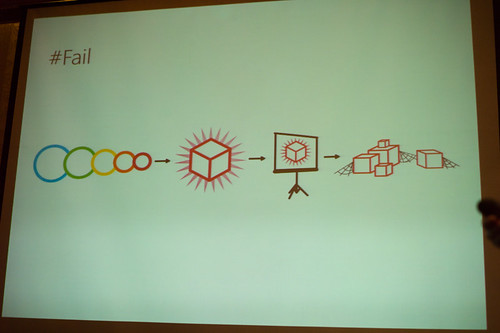
Some notes from Mike Kruzeniski‘s workshop at IxD11 on the topic of Designing Advanced Design. This is a fascinating topic to The Laboratory and equally fascinating to hear it from and participate with Mike, who is a good friend and former colleague at Nokia, of all things. Mike’s now at Microsoft so, like..now it might be like we’re colleagues again! At least partners in doing fascinating and unexpected things in the realm of design and technology.
Anyway. There were a number of highlights that I think are relevant. I’ll start with the general structure of the workshop, which was a workshop. ((Parenthetically, I’m a bit confused by workshops that are more someone presenting than people getting their hands a bit dirty, or going out in the world, or ignoring their iPad/iPhone update status checkers. I would even say that I don’t get the real-time twammering in a workshop. Either be there, or don’t be there. Bring a notebook. Sharpen your pen. Listen, do, speak. Okay, rant over.))
After introductions by Mike and a bit of a discussion about what advanced design might be ((I mentioned I was also quite interested in *advancing design in the sense of moving it closer to the locus of decision making, alongside of the business-y types)) Mike presented the workshop exercise. We were to build boats. Little boats. Made of plastic bits sort of like Legos but, as we would find out later — subject to subtle variations in how they can be assembled, even much more than the typical Lego brick. ((* Update: via @rhysys — they are called Stickle Bricks! *)) The group was broken up into several roles — customers, customer liaison, builders, suppliers, plant managers, quality assurance. Each group played the roles you would expect in the construction of to-spec boats. Customers would place orders which would be relayed to the operation. I was a builder so I basically tried to assemble boats as quickly as possible, making horrible but not-obvious mistakes which resulted in boats being delivered…and then rejected. Each round was broken up into 10 order cycles that ran for a short, fixed amount of time. In that period we’d try to assemble the requested amount of boats, which the customers could reject for flaws. Flaws were sent back to be disassembled so we could try again, but things moved quickly. At the end of the round ((which consisted of a number of order cycles)) a tally was made to determine the per-unit cost based on factors such as — number of workers, number of delivered boats, quantity of raw materials left over, etc. All the things you might understand to influence the cost of a boat. At the end of each round, there was a short amount of time to reconfigure the whole “plant” — increase builders, rearrange how materials moved from source to assembly, break apart assembly into multiple steps, fire people, etc. This was all in order to decreate the cost per boat. We actually did really horribly the first time — target cost: $15. our cost, like..$2500. miserable. We got better over two more rounds, but still only got down to about $30+ or something.
Some insights from this exercise, which is derived from a familiar MBA exercise. First, designers don’t seem to want to fire anyone. Second, MBA people are more than willing to fire workers (based on Mike’s description of when he participated in the exercise at a sort of MBA program). Third, companies that make things — even a few of them and not in the millions of them — are optimized for themselves to be efficient. Change breaks that kind of optimization, resulting in less efficiency, higher costs, etc.
((That third point is one reason I guess we here at the Laboratory prefer small refinements that make big impacts. Making something just a bit better, or refining it with such tenacity — simple, small, thoughtful refinements — that the consequences can become significant without significantly challenging the need for efficiency.))
In the lead-up to this exercise, Mike introduced a few simple yet important tenets surrounding advanced design. There are two basic ways for a company to compete: (1) It can be cheap; (2) It can be different (be something else.) And he introduced one of these curious “Laws” that we here at the Laboratory had never heard of: Parkinson’s Law which basically states that work expands so as to fill the time available for its completion. Or, stated another way: The demand upon a resource tends to expand to match the supply of the resource. ((And yet another way that the Laboratory’s Bureau on Time Management uses as an operating principle: If you wait until the last minute, it only takes a minute to do.))
So then we can think of advanced design as those resources set aside for other activities, which sort of means that it can get a bit out of control if we apply Parkinson’s Law. So — how does one do advanced design? What are some models and approaches?
For the workshop, Mike looked at three case studies of advanced design studios: Nokia, Microsoft and Nike. Each has somewhat different approaches to advanced design, which he laid out. ((I may get the details of the case studies slightly off, but the substance is what I recall and what I think is the significant points.))
3 Approaches to Advanced Design
1. The Outlier
This is the advanced design studio that thinks about “what if?” scenarios, and explores to the side, looking at perhaps total departures from the conventional wisdom. Real out-there stuff that challenges and provokes. He offered three examples of The Outlier: BMW’s Gina Concept car from 2008; Nokia’s Homegrown project; Xbox Kinect
2. The Pantry
A bit like squirreling things away in the pantry for when the weather goes all awry and you’re trapped and can’t get out and don’t want to starve. You do things even if they’re not assigned to go to market. The case study Mike offered was Nike who’s design studio maintains an active bit of work exploring, researching new materials and the like. In the case study, Nike was outdone by Under Armour sports kit who created an intense following amongst various gladiator sports like Football and the like. They broadsided Nike whose marketing people went to design and said, like..help. Design did not start a specific program from scratch to address this, but went to their “pantry” and put together a package from the existing “advanced design” material to create a bit of sports kit that made Football’rs look super scary..like robotic gladiators. Plus, presumably — it worked as equipment. One intriguing thing Mike mentioned was that some folks had been doing some studies on motion and the like with sports folks and found out that feet and hands move the most, so they highlighted feets and hands by bringing out these intense dayglo colorations to the materials used in gloves and sneakers so the players *look fast. I found this fascinating.
3. The Northstar
This is where design works towards an advanced goal, but it’s more an aspirational target that is steered towards, perhaps indirectly. This might best be described as evolving a vision, refining from what’s out there. This I think captures to a certain extent what *vision work does, although sometimes vision work is basically just a nice thing to look at without the tectonics that could activate design work. The challenge is to avoid just creating something that’s cool to look at but doesn’t give enough to make it start becoming material.
The example Mike offered in this case was Audi Avus concept car that (I know nothing about cars except how to drive them, sorta) that provided some radical new lines in 1991. It became a sort of objective point in a way — guiding the evolution of their surfacing and configurations so that over time Audi cars begin to take on the features of this Avus concept over time. The Avus provides the “Northstar” for the design team. Now — whether its stated expressly as in a lead designer saying..in 20 years lets get *here, or if it is less formal perhaps does not matter so much. Its more that this vision becomes quite tangible over time, an evolution of the car DNA.
What I find most intriguing about this sort of vision-y Northstar case of Audi in particular is that they are able to stay on course. Twenty years is a long time — even, it seems to me, in the world of automobile design where things change exceptionally slowly because of the momentum and levels of commitment necessary for manufacturing and tooling and all the rest. Yet somehow they are able to keep their eyes on this objective that must’ve seemed quite radical at the time, especially if you consider what Audi looked like in 1991.
Some random insights that came up during the workshop.
* The Apple model isn’t reproducible perhaps because it is quite driven by the owners themselves and their personalities and abilities to drive change.
* Advanced design is about change. The instinct of a company is optimization; reduce risk and costs; it will reject change.
* Our role as advanced design is to help companies *prepare for change rather than execute it. In other words, be there when things go badly and people around you start losing their head and blame you while you keep yours, and you continue to trust yourself when all those around you doubt you — in other words, when panic and confusion sets in, advanced design can lead at those moments of epic, systemic change.
What is advanced design?
Let’s take this from the perspective of “advancing” design. The “advanced” moniker seems quite old fashioned. Advancing design, or advanced designing seem like useful semantic word play. The semantics help me think about design as something that can move forward (advancing design), rather than designing something in advance of something else (as advanced design would imply), or designing in a way that is different from what is designed today (or what is thought of as design today). In that way, advancing and poking and provoking means more than differentiation. It means more than using advanced techniques.
Some notes/thoughts about what advanced/advancing design or advanced designing might be:
* working through ideas differently
* designing the way of designing always, for each and ever
* iteration, refinement — put it up, strip it back, put it back up again
* communicating tangibly, materially
* storytelling — film, prose, language
* design fiction – actively suspending disbelief. making props and probes and prototypes.
* proto-typing – making stuff, in the shop, at the bench, learning by making and doing
* photography – way better than clip-art and it forces a different kind of conversation and moves things away from *only working at the screen in Illustrator
Why do I blog this? Because I went to the workshop; it made me think of a few useful things; I’ve been sitting on this in draft state for almost two months.
Continue reading IxD 2011 Designing Advanced Design Workshop
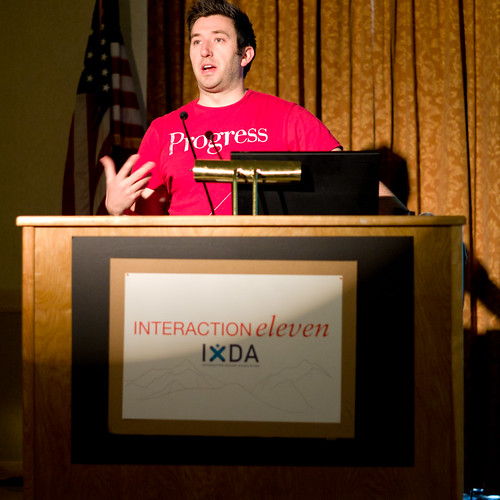
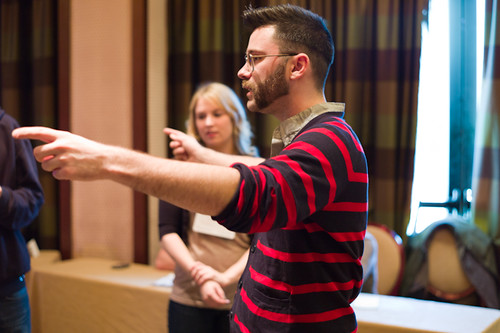
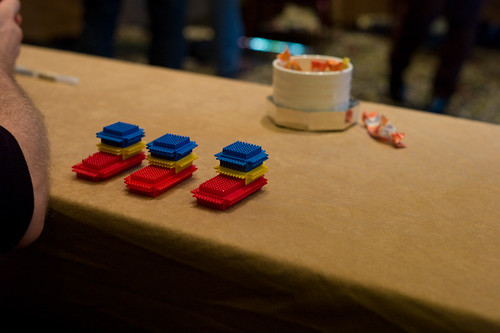

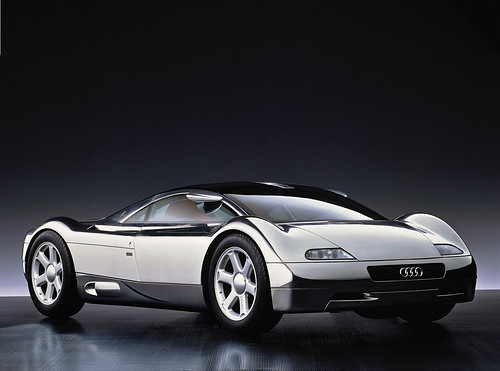
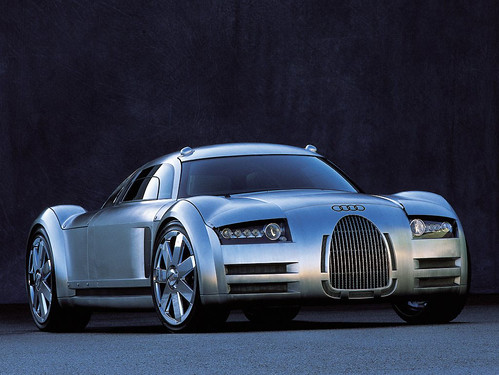




Positions Available: 1
The graduate Media Design Program (MDP) at Art Center College of Design is looking for a full-time faculty member with a background in design, culture, and technology to begin Fall 2011. The faculty member will work with other faculty from design and social science backgrounds to develop a new curriculum for a track within the Media Design MFA called “Media Design Matters” (MDM), that brings together media design, social research, public policy, and information technologies to address social issues in an applied context. Media Design Program students are world class and come from diverse disciplinary and national backgrounds.
artcenter.edu/mdp/matters/
The MDM curriculum will be built around an 8-month team-based project conducted in the field in partnership with an NGO, development agency, national non-profit or local community. Our first project partner for 2012 will be the U.S. Fund for UNICEF.
The new degree track is a collaboration between the Media Design Program and Designmatters. Designmatters is a college-wide initiative exploring social and humanitarian design and helped Art Center become the first design college to receive United Nations Non-Governmental (NGO) status. designmatters.artcenter.edu
Position Description:
As one of three core faculty members for the Media Design Matters track, this position is for a person who has at least minimal experience in each of the categories below:
● working knowledge of the basics of programming and electronics
● hands-on design with communication technologies and systems in applied contexts with real people, in any of the following: ubiquitous computing, web design and development, mobile design, interaction design, UX, service design, media design, HCI, hardware sketching, and/or social networking;
● a critical framework for understanding design, technology, culture, and power in diverse social contexts;
● experience building communications with existing resources through a design approach such as: reuse or repair, second-hand electronics, DIY, repurposing third-party applications or services (analog/digital, high/low tech), working within open source communities, maker/kit culture, etc.
Within the Media Design Program, core faculty members work collaboratively on program curriculum and philosophy and are responsible for one or two assigned areas of administration or research. We are looking for someone who is specifically interested in emerging social and cultural roles for design and technology and who is interested in building connections with the same at other academic institutions or companies throughout Southern California and around the world. The curriculum is still being designed so there is an opportunity to develop and test new pedagogy that brings a critical approach to applied research with people, technology, and social issues.
The faculty member will be required to travel in both the Fall and the Spring for the MDM project. The project location will change from year to year and could be as far away as Uganda or as close as downtown Los Angeles. Faculty members will have the opportunity to use the MDM project situation to conduct their own research in parallel, if desired.
Candidates will be eligible for a 3-year renewable full-time contract. The “core faculty” designation is a premier position at Art Center. Faculty will be expected to maintain an active research practice. Salary will be commensurate with professional experience and teaching.
Qualifications:
We are looking for an individual with a demonstrated commitment to building innovative approaches to emerging issues and interdisciplinary practice and to developing a strong context for their own practice. Candidates should have a minimum of the following: a masters degree in their field; three years teaching experience, full- or part-time; and five years creative practice in applied and/or research contexts. Experience with any of the following, while not required, is a definite plus: working across cultures, working in the field, managing projects, managing IT partnerships, developing funding relationships, working with non-profits or development agencies.
Application Process and Materials:
Posting dates: March 23, 2011 – open until filled. For best consideration apply before April 15, 2011. Review of applications to begin immediately.
Please send the following as email attachments: a cover letter, c.v., statements of professional and/or research interests and philosophy regarding pedagogy and technology, and contact information for three references. References will not be contacted until a final interview has taken place.
Please provide either a URL by email or digital portfolio on disk by mail showing a range of personal, professional, and/or student work that demonstrates abilities in the areas identified above.
Please send questions and/or application with reference to “MDM Full-time Faculty-D/T” to:
HR@artcenter.edu
Human Resources
Attn: Nancy Duggan
Art Center College of Design
1700 Lida Street
Pasadena, CA 91103
About the Graduate Media Design Program
Art Center’s graduate program in Media Design offers a two- or three-year Master of Fine Arts curriculum that helps ambitious designers from a variety of backgrounds become design leaders and researchers in emerging fields. Graduate Media Design prepares designers for a world in which virtually anything—from a new material to a global network—may be the next medium or platform of communication. artcenter.edu/mdp/
About Art Center College of Design
Founded in 1930 and located in Pasadena, California, Art Center College of Design is a global leader in art and design education and the first design school to receive the United Nations’ Non-Governmental Organization (NGO) status. Art Center offers bachelor’s degrees in advertising, entertainment design, environmental design, film, fine art, graphic design, illustration, photography and imaging, product design and transportation design. A graduate program of study can lead to a master’s degree in art, broadcast cinema, industrial design and media design. The college also offers a series of programs for the general public, including Art Center at Night, its continuing studies program; Saturday High for high school students; Art Center for Kids for children in the fourth through eighth grades; and the Design-Based Learning program for K-12 educators. artcenter.edu
Art Center College of Design is an Equal Opportunity Employer.